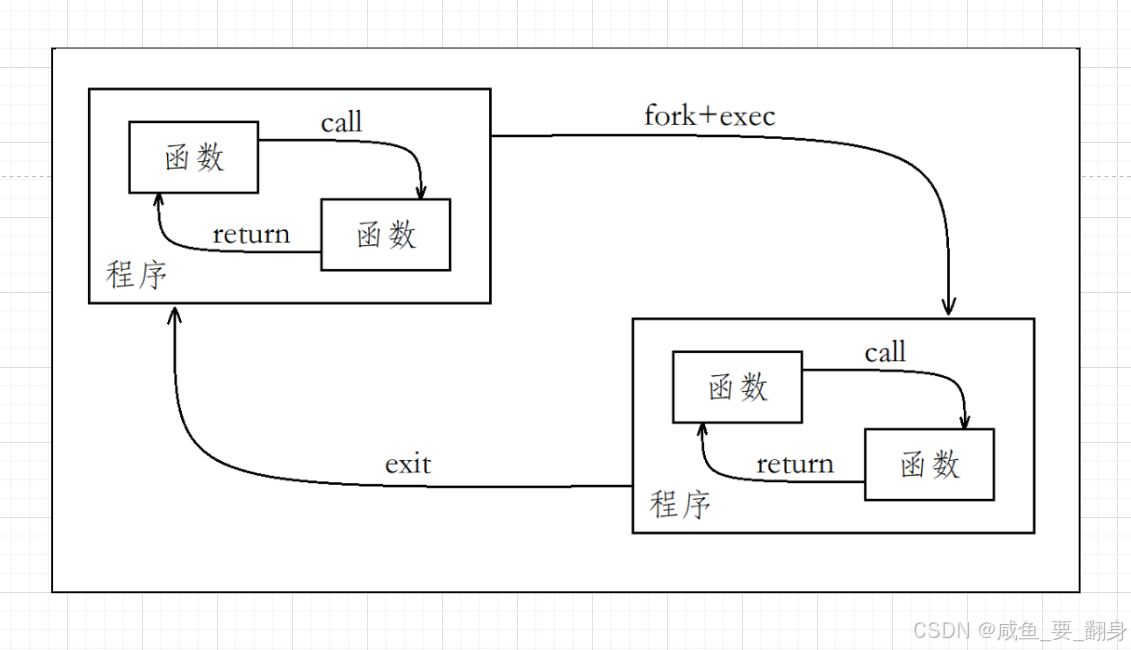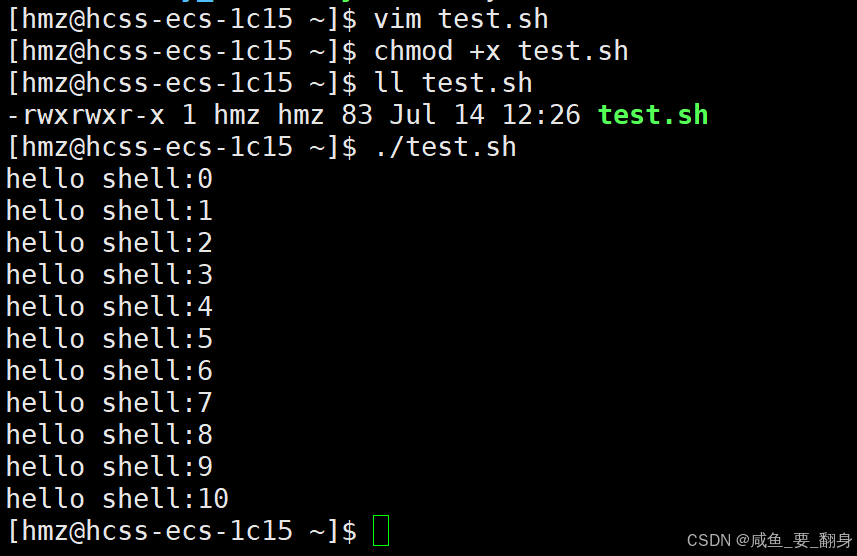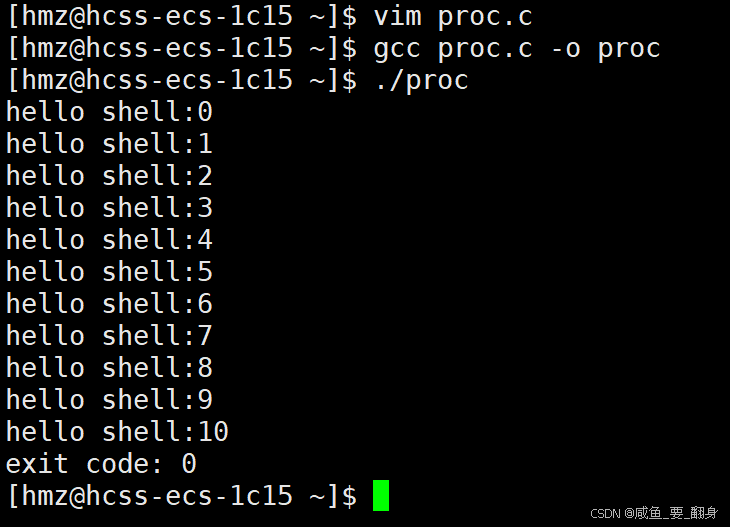从函数调用到进程通信:Linux下的多语言协作实践
目录
程序间调用的优势之一
1、Shell脚本
脚本功能说明:
执行效果
使用方法:
2、Python 脚本 (python.py)
功能说明:
使用方法:
输出:
3、C++ 程序 (test.cc)
功能说明:
编译与运行:
输出:
4、三者的对比总结
补充说明
程序替换
C 程序 (proc.c)
功能说明
编译与运行
对比表格
总结
当你掌握了C语言、C++或Java等高级语言时,你可能仅了解函数间的相互调用。但随着深入学习进程相关知识,你会发现程序之间同样可以实现相互调用。在学习新内容之前,我们先探讨函数与进程的相似性。exec/exit 机制类似于函数调用中的 call/return 模式。
以C语言为例,你应该掌握以下核心概念:
- 一个C程序由多个函数构成,函数之间可以相互调用并传递参数
- 被调函数执行特定操作后会返回结果值
- 每个函数都拥有独立的局部变量空间
- 函数间通过call/return机制进行通信
这种基于参数传递和返回值、在保持数据私密性的函数间进行通信的模式,构成了结构化程序设计的基础。Linux系统将这种程序内部的设计理念进一步扩展到了程序间的交互中,如下图所示:

通过fork系统调用,父进程可以创建子进程。随后使用exec系列函数,子进程能够加载并执行其他程序,替换原有代码和数据,子进程通过exit(n)返回状态值,父进程则通过wait(&ret)系统调用获取子进程的退出状态。这种机制实现了程序间的调用与切换。
pid_t id = fork();
if (id == 0){execvp(myargv[0], myargv);exit(1);
} 程序执行完毕后,会通过exit(n)返回一个状态值。调用进程可使用wait或waitpid函数来获取该返回值。
wait(&status);
waitpid(id, &status, 0);程序间调用的优势之一
不同编程语言各有其特长,在实际开发中,我们常需要组合使用多种语言。通过程序间的相互调用,就能实现不同语言的无缝衔接。
例如,C程序可以通过exec系列函数来调用Shell脚本、Python或C++等语言编写的程序。
1、Shell脚本
这是一个简单的 Bash 脚本文件 test.sh,内容如下:
#!/bin/bashi=0
while [ $i -le 10 ]
doecho "hello shell:$i"let i++
done脚本功能说明:
-
#!/bin/bash:指定脚本使用 Bash 解释器执行。 -
i=0:初始化变量i的值为 0。 -
while [ $i -le 10 ]:当i的值小于或等于 10 时,循环继续执行。 -
echo "hello shell:$i":打印字符串hello shell:并附带当前i的值。 -
let i++:每次循环结束后,将i的值加 1。 -
done:标记循环结束。
执行效果
运行此脚本会输出 11 行内容(从 i=0 到 i=10),每行格式为 hello shell: 后跟当前循环计数器的值。
使用方法:
-
将脚本保存为
test.sh。 -
赋予执行权限:
chmod +x test.sh。 -
运行脚本:
./test.sh。
输出示例:

2、Python 脚本 (python.py)
#!/usr/bin/pythonprint("hello python!")功能说明:
-
#!/usr/bin/python:指定脚本使用 Python 解释器执行。 -
print("hello python!"):打印字符串hello python!。
使用方法:
-
将脚本保存为
python.py。 -
赋予执行权限(可选):
chmod +x python.py。 -
运行脚本:
-
直接执行:
./test.py(需确保 Python 路径正确)。 -
或通过 Python 解释器运行:
python python.py。
-
输出:

3、C++ 程序 (test.cc)
#include <iostream>
using namespace std;int main()
{cout << "hello C++" << endl;return 0;
}功能说明:
-
#include <iostream>:引入标准输入输出库。 -
using namespace std:使用标准命名空间,避免重复写std::。 -
cout << "hello C++" << endl:打印字符串hello C++并换行。 -
return 0:表示程序正常退出。
编译与运行:
-
将代码保存为
test.cc。 -
编译(需安装 g++):
g++ test.cc -o test -
运行生成的可执行文件:
./test
输出:

4、三者的对比总结
| 特性 | Bash 脚本 | Python 脚本 | C++ 程序 |
|---|---|---|---|
| 文件扩展名 | .sh | .py | .cc 或 .cpp |
| 执行方式 | 解释执行(直接或通过 Bash) | 解释执行(直接或通过 Python) | 需编译后运行二进制文件 |
| 语法复杂度 | 简单(面向命令) | 简洁(高级抽象) | 复杂(需管理内存、类型等) |
| 性能 | 低(依赖系统 Shell) | 中等(解释器开销) | 高(直接编译为机器码) |
| 典型用途 | 系统管理、自动化任务 | 快速开发、脚本工具 | 高性能应用、底层开发 |
| 依赖 | 需 Bash 环境 | 需 Python 环境 | 需编译器(如 g++) |
补充说明
-
Bash 脚本 (
test.sh):适用于 Linux/Unix 系统自动化任务,无需编译,直接解释执行。 -
Python 脚本 (
test.py):跨平台,适合快速开发,解释执行,依赖 Python 环境。 -
C++ 程序 (
test.cc):高性能场景,需编译(如g++ test.cc -o test),生成可执行文件后运行。
程序替换
我们使用以下C程序,便可以分别调用以上三个程序:
C 程序 (proc.c)
#include <stdio.h>
#include <stdlib.h>
#include <unistd.h>
#include <sys/types.h>
#include <sys/wait.h>int main() {pid_t id = fork();if (id == 0) {// 子进程execl("./test.sh", "test.sh", NULL); // 调用 Bash 脚本// execl("./python.py", "python.py", NULL); // 调用 Python 脚本// execl("./test", "test", NULL); // 调用 C++ 程序exit(1); // 若 execl 失败则退出}// 父进程等待子进程结束int status = 0;pid_t ret = waitpid(id, &status, 0);if (ret > 0) {printf("exit code: %d\n", WEXITSTATUS(status));}return 0;
}功能说明
-
多进程控制:
-
使用
fork()创建子进程,子进程通过execl()调用外部程序。 -
父进程通过
waitpid()等待子进程结束,并获取其退出状态码。
-
-
调用方式:
-
Bash 脚本:
execl("./test.sh", "test.sh", NULL) -
Python 脚本:
execl("./python.py", "python.py", NULL)(需取消注释) -
C++ 程序:
execl("./test", "test", NULL)(需先编译test.cc生成test)
-
-
注意事项:
-
被调用的程序(如
test.sh、python.py、test)需具有可执行权限。 -
若
execl()调用失败,子进程会执行exit(1),父进程捕获的退出码为1。
-
编译与运行
-
编译 C 程序:
gcc proc.c -o proc -
运行程序:
./proc -
输出示例:
调用shell脚本运行结果:

调用python运行结果:

调用C++运行结果:

对比表格
| 调用目标 | 语言 | 需提前准备 | C 中调用方法 |
|---|---|---|---|
test.sh | Bash | 赋予执行权限 (chmod +x) | execl("./test.sh", "test.sh", NULL) |
test.py | Python | 确保 Python 环境可用 | execl("./python.py", "python.py", NULL) |
test | C++ | 编译生成可执行文件 (g++) | execl("./test", "test", NULL) |
总结
-
用途:该 C 程序通过进程管理实现了对多种语言脚本/程序的灵活调用,适用于需要混合编程的场景(如用 C 控制任务流程,调用其他语言模块)。
-
扩展性:可通过修改
execl()参数调用其他外部程序(如 Perl、Java 等)。
